diff options
Diffstat (limited to 'docs/guides/monitor/kubernetes-k8s-netdata.md')
| -rw-r--r-- | docs/guides/monitor/kubernetes-k8s-netdata.md | 246 |
1 files changed, 0 insertions, 246 deletions
diff --git a/docs/guides/monitor/kubernetes-k8s-netdata.md b/docs/guides/monitor/kubernetes-k8s-netdata.md deleted file mode 100644 index 96d79935b..000000000 --- a/docs/guides/monitor/kubernetes-k8s-netdata.md +++ /dev/null @@ -1,246 +0,0 @@ -# Kubernetes monitoring with Netdata - -This document gives an overview of what visualizations Netdata provides on Kubernetes deployments. - -At Netdata, we've built Kubernetes monitoring tools that add visibility without complexity while also helping you -actively troubleshoot anomalies or outages. This guide walks you through each of the visualizations and offers best -practices on how to use them to start Kubernetes monitoring in a matter of minutes, not hours or days. - -Netdata's Kubernetes monitoring solution uses a handful of [complementary tools and -collectors](#related-reference-documentation) for peeling back the many complex layers of a Kubernetes cluster, -_entirely for free_. These methods work together to give you every metric you need to troubleshoot performance or -availability issues across your Kubernetes infrastructure. - -## Challenge - -While Kubernetes (k8s) might simplify the way you deploy, scale, and load-balance your applications, not all clusters -come with "batteries included" when it comes to monitoring. Doubly so for a monitoring stack that helps you actively -troubleshoot issues with your cluster. - -Some k8s providers, like GKE (Google Kubernetes Engine), do deploy clusters bundled with monitoring capabilities, such -as Google Stackdriver Monitoring. However, these pre-configured solutions might not offer the depth of metrics, -customization, or integration with your preferred alerting methods. - -Without this visibility, it's like you built an entire house and _then_ smashed your way through the finished walls to -add windows. - -## Solution - -In this tutorial, you'll learn how to navigate Netdata's Kubernetes monitoring features, using -[robot-shop](https://github.com/instana/robot-shop) as an example deployment. Deploying robot-shop is purely optional. -You can also follow along with your own Kubernetes deployment if you choose. While the metrics might be different, the -navigation and best practices are the same for every cluster. - -## What you need to get started - -To follow this tutorial, you need: - -- A free Netdata Cloud account. [Sign up](https://app.netdata.cloud/sign-up?cloudRoute=/spaces) if you don't have one - already. -- A working cluster running Kubernetes v1.9 or newer, with a Netdata deployment and connected parent/child nodes. See - our [Kubernetes deployment process](https://github.com/netdata/netdata/blob/master/packaging/installer/methods/kubernetes.md) for details on deployment and - conneting to Cloud. -- The [`kubectl`](https://kubernetes.io/docs/reference/kubectl/overview/) command line tool, within [one minor version - difference](https://kubernetes.io/docs/tasks/tools/install-kubectl/#before-you-begin) of your cluster, on an - administrative system. -- The [Helm package manager](https://helm.sh/) v3.0.0 or newer on the same administrative system. - -### Install the `robot-shop` demo (optional) - -Begin by downloading the robot-shop code and using `helm` to create a new deployment. - -```bash -git clone git@github.com:instana/robot-shop.git -cd robot-shop/K8s/helm -kubectl create ns robot-shop -helm install robot-shop --namespace robot-shop . -``` - -Running `kubectl get pods` shows both the Netdata and robot-shop deployments. - -```bash -kubectl get pods --all-namespaces -NAMESPACE NAME READY STATUS RESTARTS AGE -default netdata-child-29f9c 2/2 Running 0 10m -default netdata-child-8xphf 2/2 Running 0 10m -default netdata-child-jdvds 2/2 Running 0 11m -default netdata-parent-554c755b7d-qzrx4 1/1 Running 0 11m -kube-system aws-node-jnjv8 1/1 Running 0 17m -kube-system aws-node-svzdb 1/1 Running 0 17m -kube-system aws-node-ts6n2 1/1 Running 0 17m -kube-system coredns-559b5db75d-f58hp 1/1 Running 0 22h -kube-system coredns-559b5db75d-tkzj2 1/1 Running 0 22h -kube-system kube-proxy-9p9cd 1/1 Running 0 17m -kube-system kube-proxy-lt9ss 1/1 Running 0 17m -kube-system kube-proxy-n75t9 1/1 Running 0 17m -robot-shop cart-b4bbc8fff-t57js 1/1 Running 0 14m -robot-shop catalogue-8b5f66c98-mr85z 1/1 Running 0 14m -robot-shop dispatch-67d955c7d8-lnr44 1/1 Running 0 14m -robot-shop mongodb-7f65d86c-dsslc 1/1 Running 0 14m -robot-shop mysql-764c4c5fc7-kkbnf 1/1 Running 0 14m -robot-shop payment-67c87cb7d-5krxv 1/1 Running 0 14m -robot-shop rabbitmq-5bb66bb6c9-6xr5b 1/1 Running 0 14m -robot-shop ratings-94fd9c75b-42wvh 1/1 Running 0 14m -robot-shop redis-0 0/1 Pending 0 14m -robot-shop shipping-7d69cb88b-w7hpj 1/1 Running 0 14m -robot-shop user-79c445b44b-hwnm9 1/1 Running 0 14m -robot-shop web-8bb887476-lkcjx 1/1 Running 0 14m -``` - -## Explore Netdata's Kubernetes monitoring charts - -The Netdata Helm chart deploys and enables everything you need for monitoring Kubernetes on every layer. Once you deploy -Netdata and connect your cluster's nodes, you're ready to check out the visualizations **with zero configuration**. - -To get started, [sign in](https://app.netdata.cloud/sign-in?cloudRoute=/spaces) to your Netdata Cloud account. Head over -to the War Room you connected your cluster to, if not **General**. - -Netdata Cloud is already visualizing your Kubernetes metrics, streamed in real-time from each node, in the -[Overview](https://github.com/netdata/netdata/blob/master/docs/cloud/visualize/overview.md): - -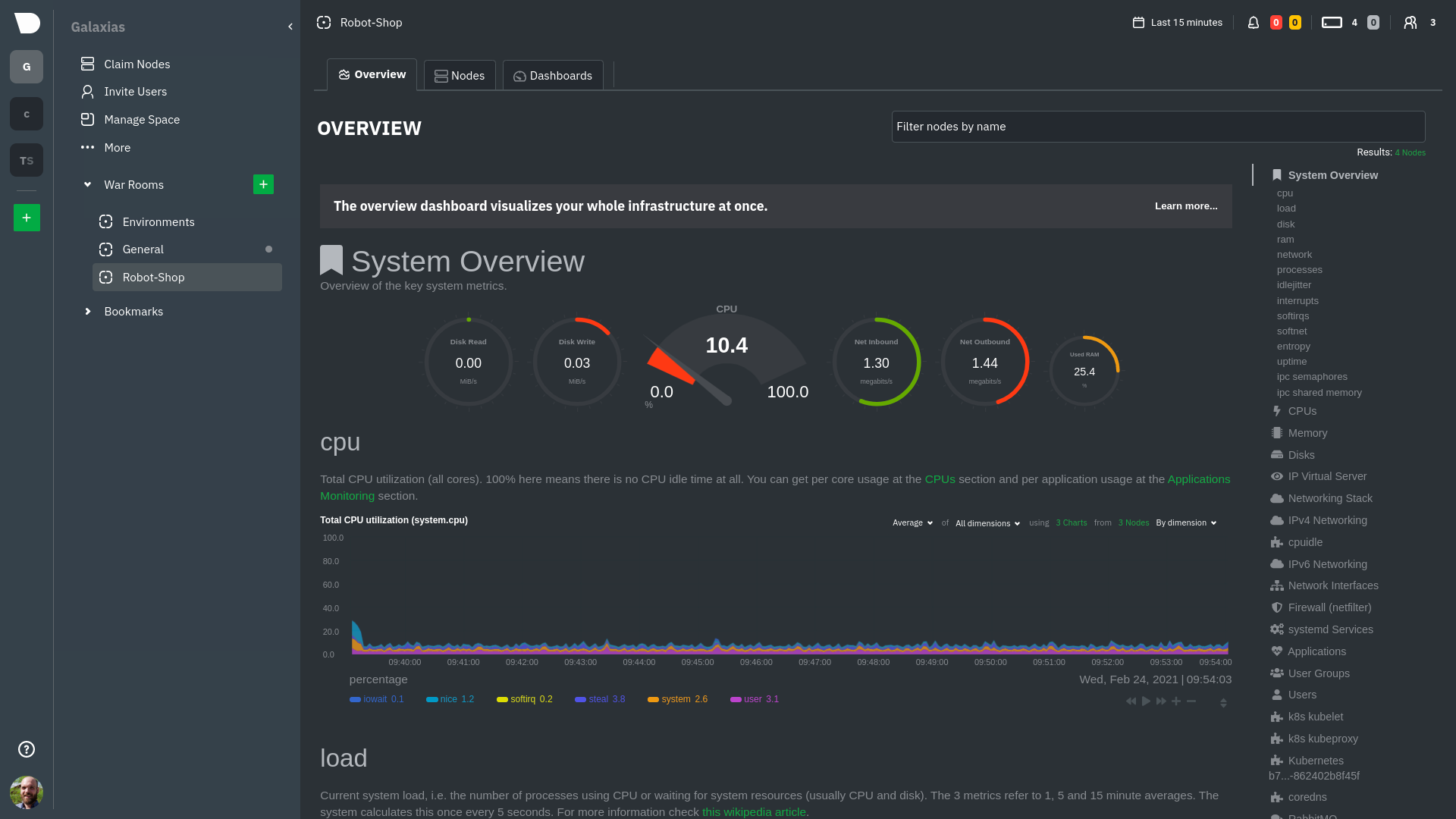 - -Let's walk through monitoring each layer of a Kubernetes cluster using the Overview as our framework. - -## Cluster and node metrics - -The gauges and time-series charts you see right away in the Overview show aggregated metrics from every node in your -cluster. - -For example, the `apps.cpu` chart (in the **Applications** menu item), visualizes the CPU utilization of various -applications/services running on each of the nodes in your cluster. The **X Nodes** dropdown shows which nodes -contribute to the chart and links to jump a single-node dashboard for further investigation. - -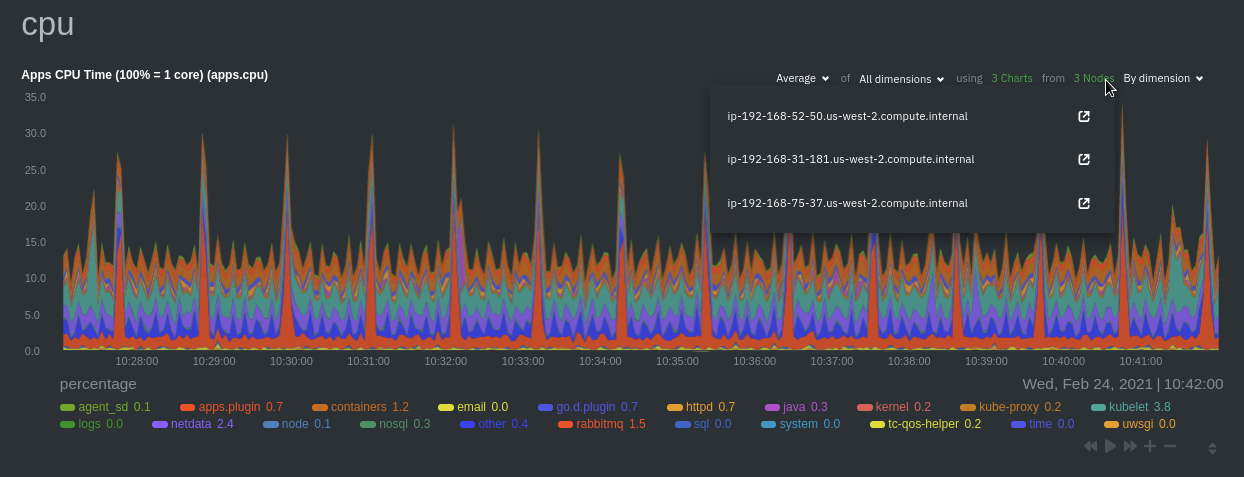 - -For example, the chart above shows a spike in the CPU utilization from `rabbitmq` every minute or so, along with a -baseline CPU utilization of 10-15% across the cluster. - -Read about the [Overview](https://github.com/netdata/netdata/blob/master/docs/cloud/visualize/overview.md) and some best practices on [viewing -an overview of your infrastructure](https://github.com/netdata/netdata/blob/master/docs/visualize/overview-infrastructure.md) for details on using composite charts to -drill down into per-node performance metrics. - -## Pod and container metrics - -Click on the **Kubernetes xxxxxxx...** section to jump down to Netdata Cloud's unique Kubernetes visualizations for view -real-time resource utilization metrics from your Kubernetes pods and containers. - -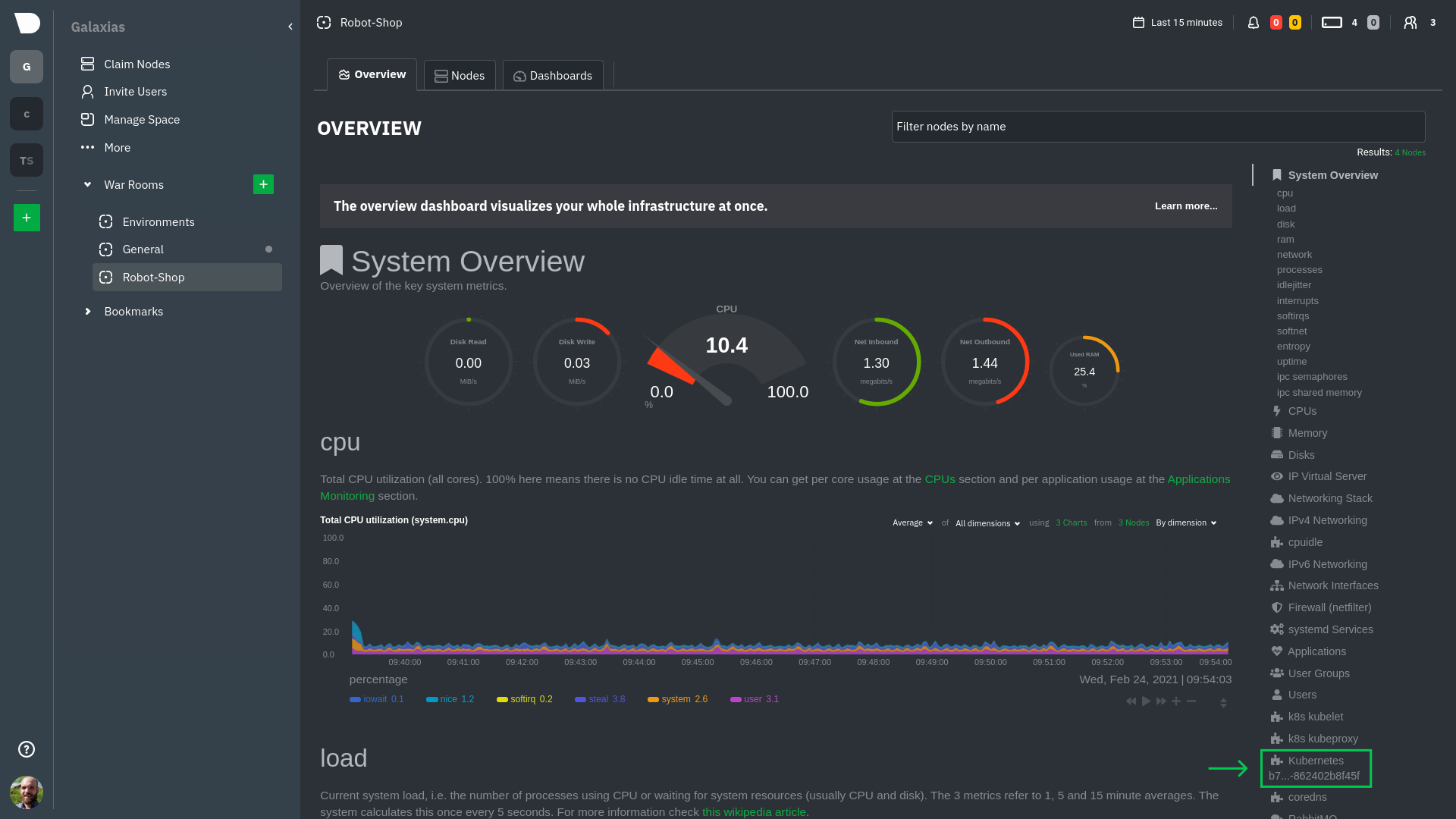 - -### Health map - -The first visualization is the [health map](https://github.com/netdata/netdata/blob/master/docs/cloud/visualize/kubernetes.md#health-map), -which places each container into its own box, then varies the intensity of their color to visualize the resource -utilization. By default, the health map shows the **average CPU utilization as a percentage of the configured limit** -for every container in your cluster. - -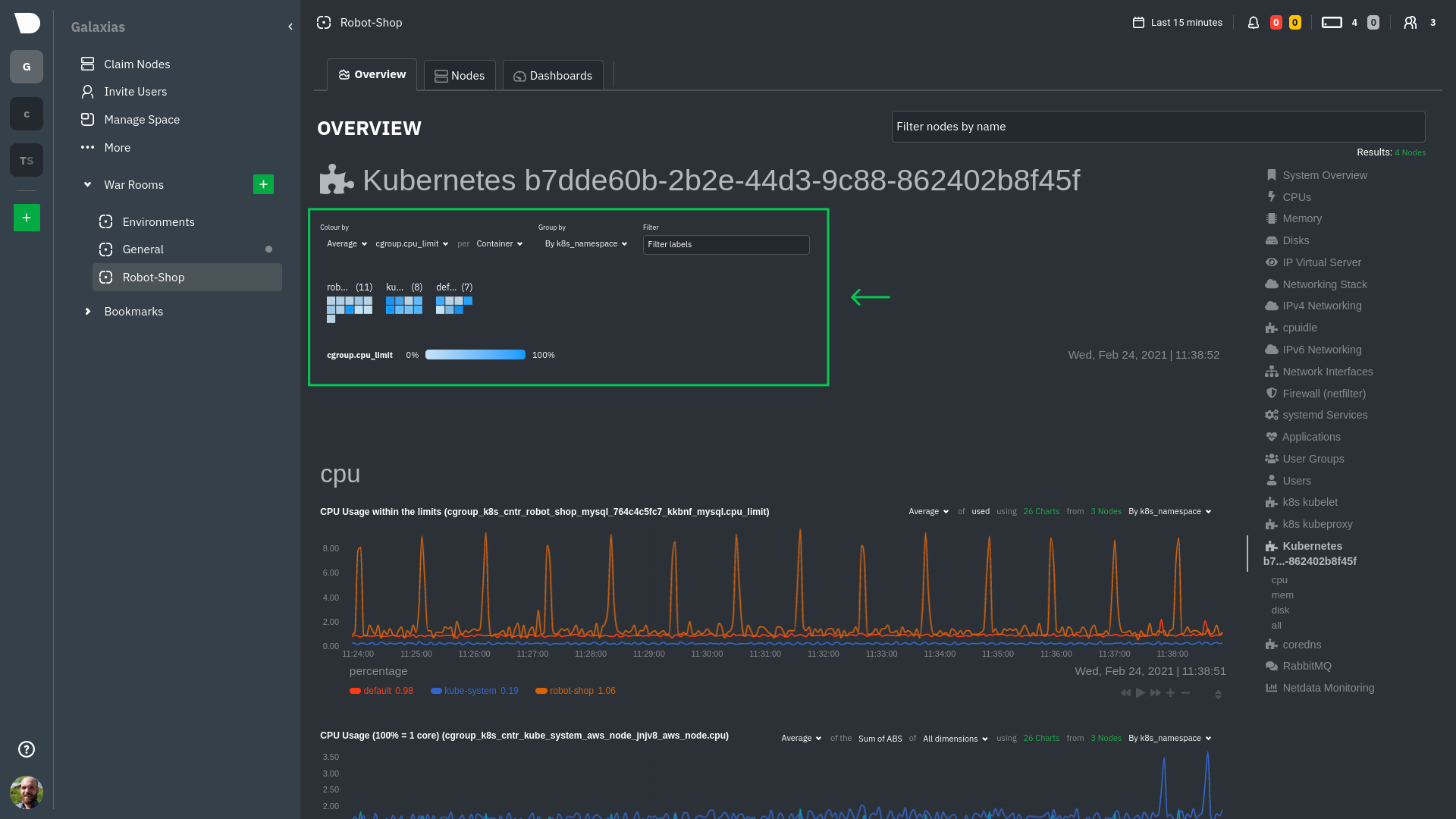 - -Let's explore the most colorful box by hovering over it. - -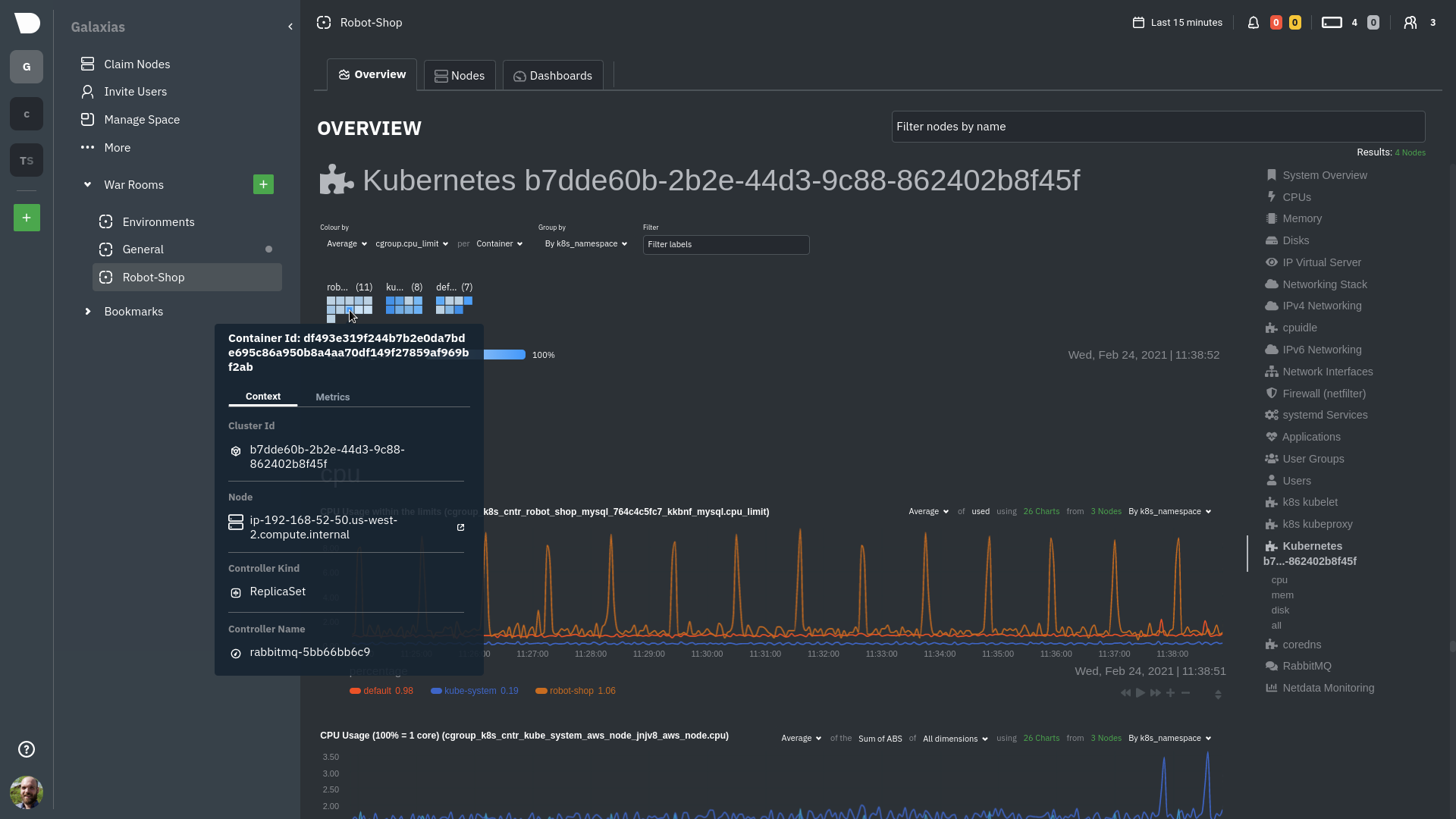 - -The **Context** tab shows `rabbitmq-5bb66bb6c9-6xr5b` as the container's image name, which means this container is -running a [RabbitMQ](https://github.com/netdata/go.d.plugin/blob/master/modules/rabbitmq/README.md) workload. - -Click the **Metrics** tab to see real-time metrics from that container. Unsurprisingly, it shows a spike in CPU -utilization at regular intervals. - -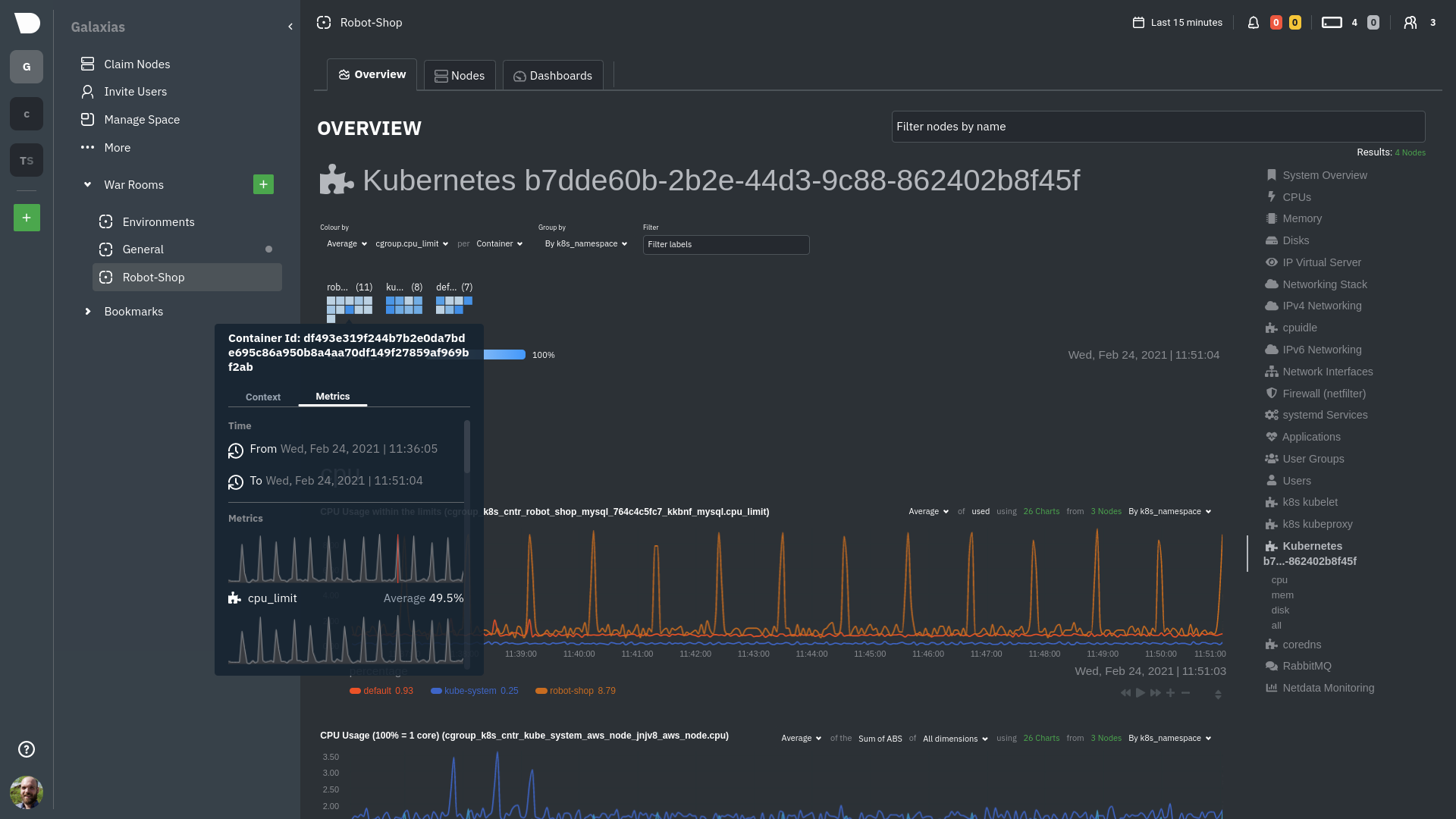 - -### Time-series charts - -Beneath the health map is a variety of time-series charts that help you visualize resource utilization over time, which -is useful for targeted troubleshooting. - -The default is to display metrics grouped by the `k8s_namespace` label, which shows resource utilization based on your -different namespaces. - -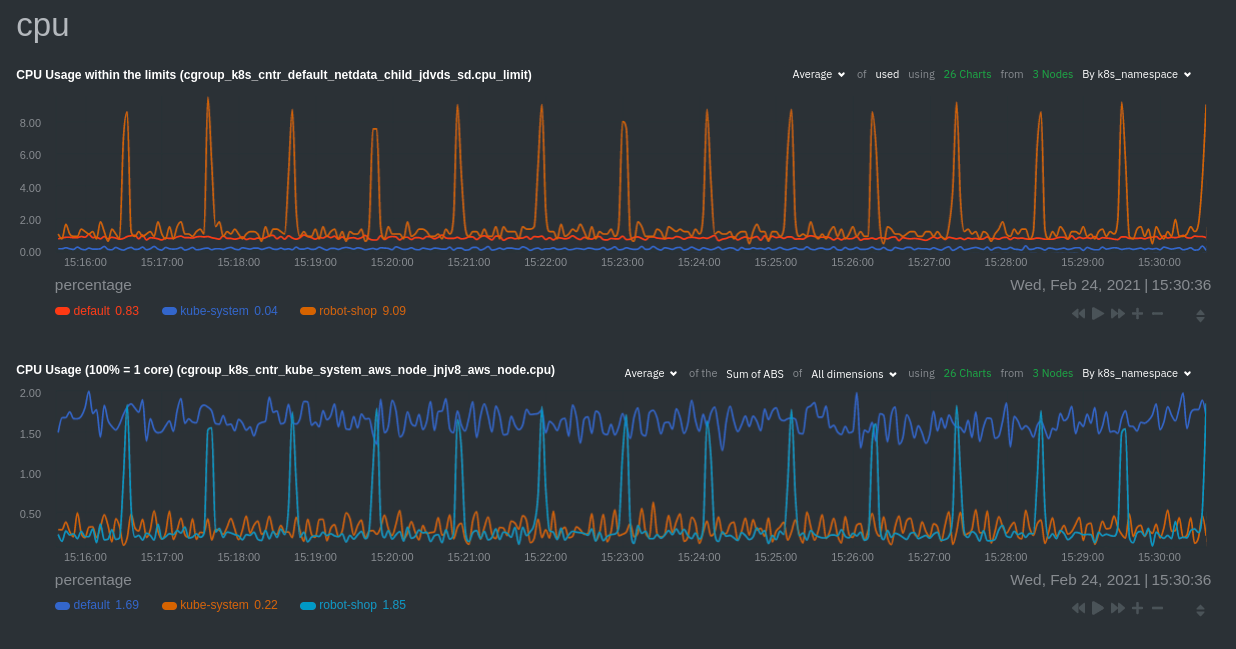 - -Each composite chart has a [definition bar](https://github.com/netdata/netdata/blob/master/docs/cloud/visualize/overview.md#definition-bar) -for complete customization. For example, grouping the top chart by `k8s_container_name` reveals new information. - -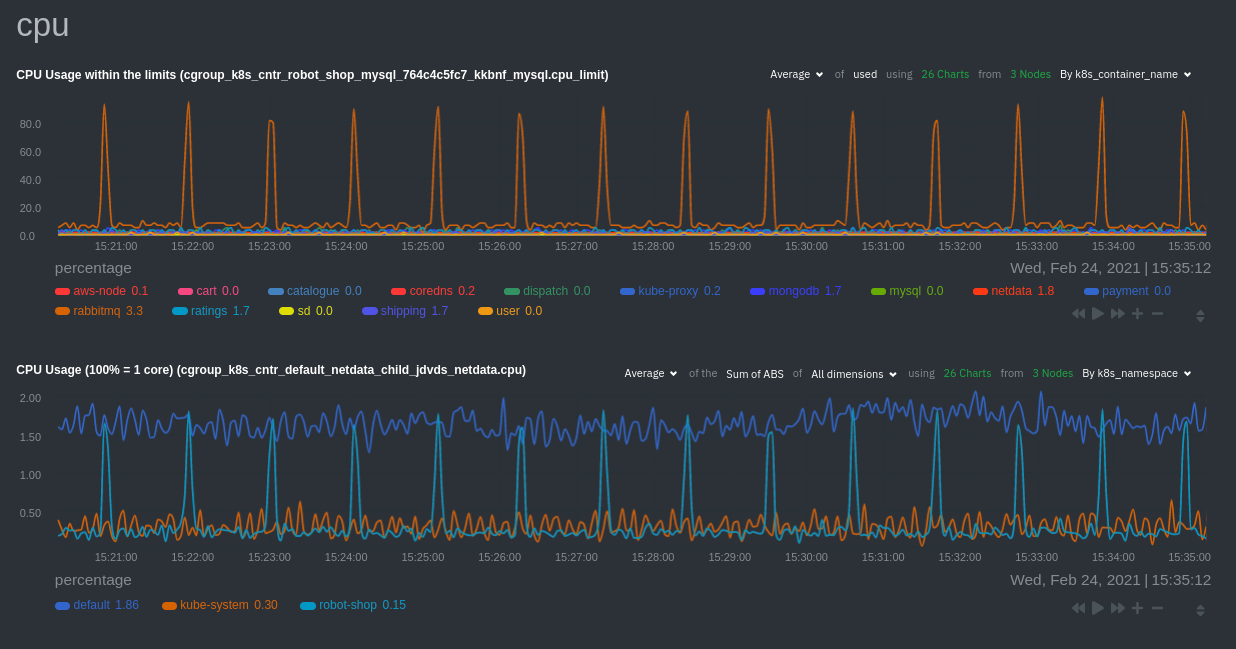 - -## Service metrics - -Netdata has a [service discovery plugin](https://github.com/netdata/agent-service-discovery), which discovers and -creates configuration files for [compatible -services](https://github.com/netdata/helmchart#service-discovery-and-supported-services) and any endpoints covered by -our [generic Prometheus collector](https://github.com/netdata/go.d.plugin/blob/master/modules/prometheus/README.md). -Netdata uses these files to collect metrics from any compatible application as they run _inside_ of a pod. Service -discovery happens without manual intervention as pods are created, destroyed, or moved between nodes. - -Service metrics show up on the Overview as well, beneath the **Kubernetes** section, and are labeled according to the -service in question. For example, the **RabbitMQ** section has numerous charts from the [`rabbitmq` -collector](https://github.com/netdata/go.d.plugin/blob/master/modules/rabbitmq/README.md): - -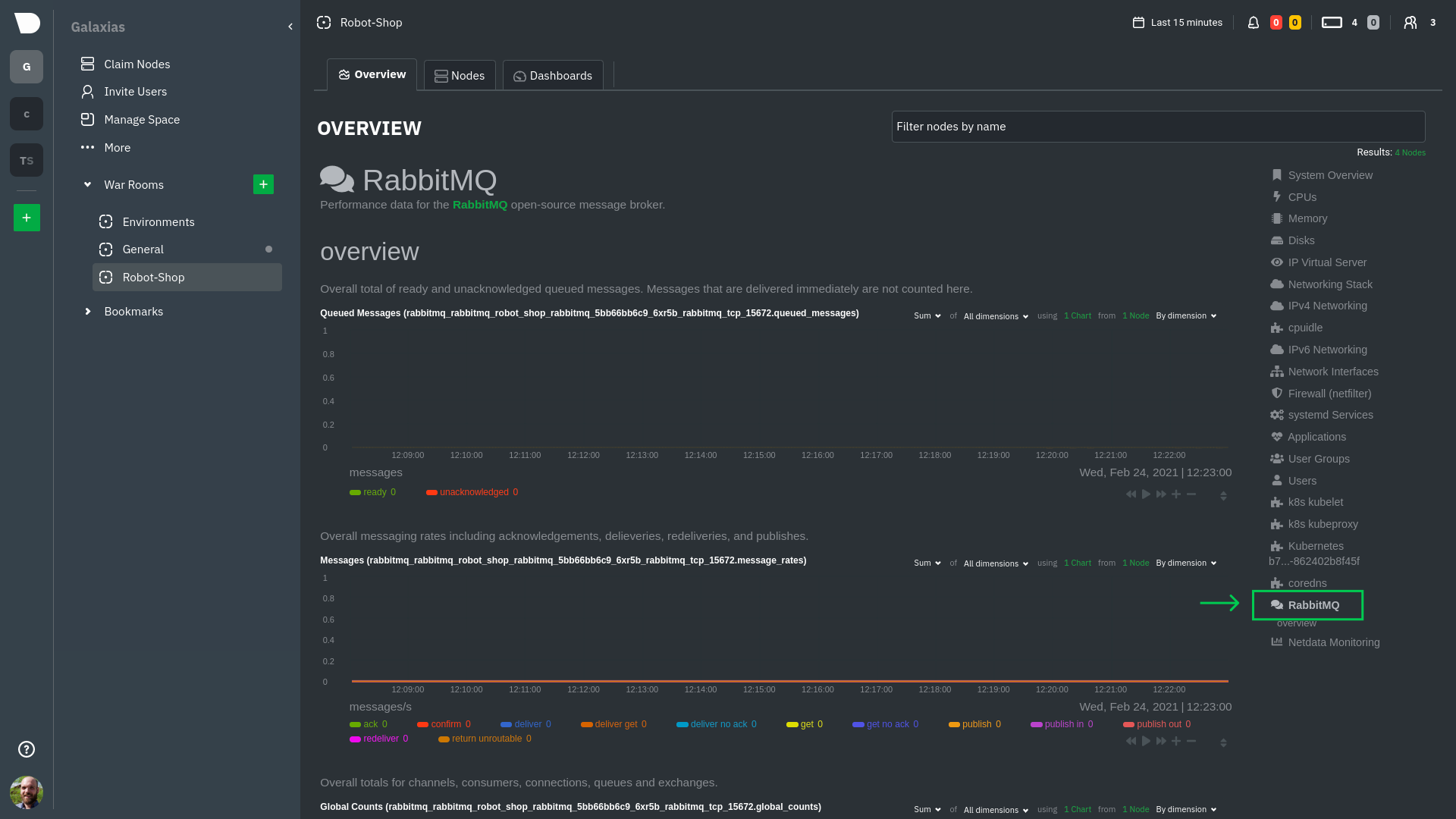 - -> The robot-shop cluster has more supported services, such as MySQL, which are not visible with zero configuration. This -> is usually because of services running on non-default ports, using non-default names, or required passwords. Read up -> on [configuring service discovery](https://github.com/netdata/netdata/blob/master/packaging/installer/methods/kubernetes.md#configure-service-discovery) to collect -> more service metrics. - -Service metrics are essential to infrastructure monitoring, as they're the best indicator of the end-user experience, -and key signals for troubleshooting anomalies or issues. - -## Kubernetes components - -Netdata also automatically collects metrics from two essential Kubernetes processes. - -### kubelet - -The **k8s kubelet** section visualizes metrics from the Kubernetes agent responsible for managing every pod on a given -node. This also happens without any configuration thanks to the [kubelet -collector](https://github.com/netdata/go.d.plugin/blob/master/modules/k8s_kubelet/README.md). - -Monitoring each node's kubelet can be invaluable when diagnosing issues with your Kubernetes cluster. For example, you -can see if the number of running containers/pods has dropped, which could signal a fault or crash in a particular -Kubernetes service or deployment (see `kubectl get services` or `kubectl get deployments` for more details). If the -number of pods increases, it may be because of something more benign, like another team member scaling up a -service with `kubectl scale`. - -You can also view charts for the Kubelet API server, the volume of runtime/Docker operations by type, -configuration-related errors, and the actual vs. desired numbers of volumes, plus a lot more. - -### kube-proxy - -The **k8s kube-proxy** section displays metrics about the network proxy that runs on each node in your Kubernetes -cluster. kube-proxy lets pods communicate with each other and accept sessions from outside your cluster. Its metrics are -collected by the [kube-proxy -collector](https://github.com/netdata/go.d.plugin/blob/master/modules/k8s_kubeproxy/README.md). - -With Netdata, you can monitor how often your k8s proxies are syncing proxy rules between nodes. Dramatic changes in -these figures could indicate an anomaly in your cluster that's worthy of further investigation. - -## What's next? - -After reading this guide, you should now be able to monitor any Kubernetes cluster with Netdata, including nodes, pods, -containers, services, and more. - -With the health map, time-series charts, and the ability to drill down into individual nodes, you can see hundreds of -per-second metrics with zero configuration and less time remembering all the `kubectl` options. Netdata moves with your -cluster, automatically picking up new nodes or services as your infrastructure scales. And it's entirely free for -clusters of all sizes. - -### Related reference documentation - -- [Netdata Helm chart](https://github.com/netdata/helmchart) -- [Netdata service discovery](https://github.com/netdata/agent-service-discovery) -- [Netdata Agent · `kubelet` - collector](https://github.com/netdata/go.d.plugin/blob/master/modules/k8s_kubelet/README.md) -- [Netdata Agent · `kube-proxy` - collector](https://github.com/netdata/go.d.plugin/blob/master/modules/k8s_kubeproxy/README.md) -- [Netdata Agent · `cgroups.plugin`](https://github.com/netdata/netdata/blob/master/collectors/cgroups.plugin/README.md) - - |
